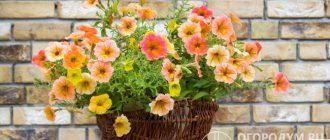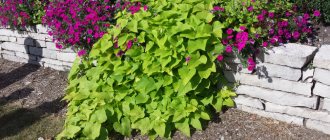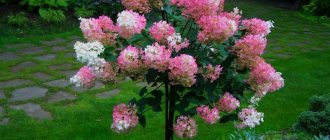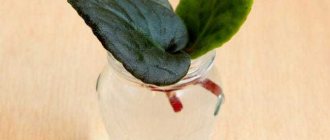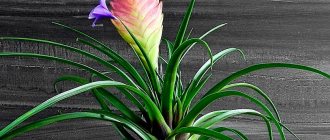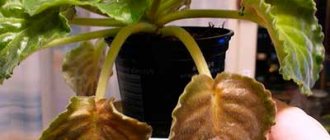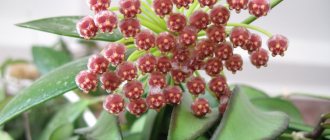Quote from son
Read in full In your quotation book or community!
Secrets of growing petunias on the balcony: the main rules for excellent results.
Surely, in the summer you have more than once paid attention to the hanging flowerpots with gorgeous petunias that were installed in street cafes, restaurants, and parks. And very often it happened that after some time, when you came there again, not a trace remained of the former beauty of the petunias. Yellow, dried lashes, single small flowers. What is this? Apparently, the conditions for growing petunia were not met. Meanwhile, petunia is a very grateful flower and, if you follow the rules of its cultivation, it will bloom profusely, almost non-stop, from May until frost. Want to know how to grow beautiful petunia?
Features of the root system of petunias
Before growing petunia in a pot, you need to study its features. An incorrect calculation when choosing a container will damage the roots of the plant and lead to its death.
Variety of petunias on the balcony
The culture has a fibrous rhizome consisting of many whitish roots. They quickly grow throughout the container, but this does not prevent the plant from being planted in flowerpots and flowerpots.
Transplanting and planting work does not cause difficulties. The process takes place in a few minutes; it is better to transfer the seedlings along with the soil in which they grew.
Petunia in pots takes root well on a loggia or in a room. It is used for room decoration.
Flower root system
Tips for decorating a balcony
When decorating a balcony with flowers, you need to make sure that they do not block the light from each other and are in harmony with the overall decoration. Containers with tall plants are placed on the floor in the corners, as well as along the wall. Low-growing and hanging ones can be placed on special shelves attached to the wall.
Pots with hanging vines are hung at different levels.
For climbing plants, trellises are often used.
It is best to place ampelous and cascading petunias in containers outside the balcony, securing them securely. Bush miniature plants are placed on a special table or stools.
Thanks to the abundance of colors, petunia can be successfully combined with each other, as well as beautifully combined with other plants.
Varieties for home cultivation
For planting in closed conditions, two types of crops are used:
- ampelous - its stems grow up to 1.2 m, hanging down, and can break off during strong gusts of wind;
- cascading - characterized by dense shoots, 1.5 m long, initially they grow upward, and then begin to smoothly fall down.
How is surfinia different from petunia - care and cultivation
The best varietal types of balcony petunia are presented:
- Velveteen - has velvety and small flowers;
- Gioconda - with purple-lavender inflorescences;
- Ekaterina - painted in salmon tones;
- Mashenka - with pink buds;
- Opera suprim - belonging to the small-flowered subspecies;
- Snow Queen - stands out with snow-white petals;
- Typhoon - with long and abundant flowering;
- Black velvet - with burgundy-black petals.
Important! All of these representatives have long, hanging shoots. The bushes are strewn with flowers with a pleasant aroma.
Petunia Ramblin'
Variety of species
To decorate balconies, flower growers use almost all existing types of petunias:
- Bush (garden) varieties are compact plants from 20 to 50 cm in height, the stems of which branch and stretch straight up. These flowers are grown in pots, balcony boxes or hanging flowerpots.
- Ampelous (creeping or hanging) varieties are distinguished by very long shoots, sometimes reaching 1.5 m. The diameter of their flowers is from 2.5 to 10 cm. There are varieties with larger flowers, but their number on the bush is smaller. Caring for hanging plants is more labor-intensive; they need to be watered more often and fed regularly.
- Cascade varieties are considered a separate category of ampelous petunias, since their long shoots are more powerful and thick, first grow upwards and to the sides, but then droop downwards under their own weight. Plants are capable of extensive branching. The flowers are mostly large (up to 10 cm in diameter).
Bush varieties are more unpretentious in care and feel great in small containers
Categories of petunias
Based on the number and size of flowers, petunias are divided into several subspecies:
| Category | Characteristic |
| Small-flowered or milliflora | Plants with small flowers (diameter from 2.5 to 4 cm) on rigid, relatively low stems (up to 25 cm). These varieties are resistant to adverse external factors and can withstand strong winds and prolonged precipitation |
| Large-flowered or grandiflora (grandiflora) | Bushy plants with large flowers, up to 15 cm in diameter. The length of the shoots can reach 65-70 cm. Successful cultivation of such flowers is possible in gentle weather and climatic conditions, since their lashes are easily damaged by gusts of wind, and the roots are susceptible to rotting after heavy rains |
| Multi-flowered or multiflora (multiflora) | Representatives of this subgroup are characterized by an abundance of small flowers, the length of the stems is up to 25–30 cm. They are relatively resistant to weather vagaries, able to withstand temperature fluctuations, exposure to precipitation and wind |
| Floribunda | Hybrids obtained by crossing grandi and multiflora combine fairly large flowers (up to 10 cm in diameter) and plant hardiness. Shoot length up to 45–50 cm |
Milliflora are unpretentious ornamental plants that can be planted in boxes, outdoor flowerpots or pots, or placed in original flowerpots
The variety of bright colors of petunia flowers is amazing - they can be plain, bordered at the edges, with spots, gradients or watercolor stains. The shape of the petals is also extremely impressive - from simple “bell-shaped” corollas to folded and voluminous (double and semi-double) with wavy, fringed or corrugated edges.
The following video introduces the varieties and best varieties of petunias:
What are the different types of pots?
How dracaena blooms - what types, proper care
Why does petunia grow poorly in pots: before planting, you need to select the right container. The florist can choose the most suitable product or create it himself.
- Kapsho
Refers to decorative containers in which pots with plants are placed. You can initially buy larger containers with an eye toward the future.
Flower in a flowerpot
- Vases
They are made of gypsum, metal, ceramic, clay, concrete or stone material. Designed for outdoor use and balconies.
- Pots
They can be made from clay, ceramics, plastic and other materials.
- Designer pots
When choosing, take into account appearance and functionality. When purchasing, pay attention to the presence of drainage, air permeability and the shape of the vessel.
Important! The best option is to buy an original flowerpot. The pot will have to be changed annually and its appearance will not play any role.
Size
The volume of the container depends on the growth rate. Gardeners prefer to choose larger containers so that the roots have enough space.
Material
It is better to take breathable options: clay, ceramic or wooden. Metal and other types can be used, but they must have drainage holes.
Important! It is better to choose light colored pots. Dark items will heat up and keep warm.
Pot options
Specialized (other types)
Non-standard containers include:
- made of silicone - the curved edges of the dish are bent as the flower grows, thereby increasing its volume;
- hanging pot and flowerpot - as an alternative to a regular flowerpot, allowing you to lift plants up;
- with lighting - flowerpots are used for room design;
- florarium - made of transparent glass, used for light-loving varieties.
Important! Containers with an automatic watering system are suitable for crops that require regular moisture.
Neon illuminated
Which pot is best for a particular flower?
Lemon tree - caring for a houseplant
When choosing a container, it is guided by the type of flower. Terry ones require a volume of 3 liters, regular ones - up to 5 liters.
How many petunias can be planted in one pot: the final quantity depends on the volume of the container. With a diameter of up to 30 cm, replanting 3 bushes is allowed.
Seedlings grown from seeds are small in size and are initially planted in a small temporary container. The size should exceed the volume of the roots by 3-4 cm.
Containers for seedlings
Two types of soil moisture are usually used:
- artificial - with adjustment of the volume of liquid, the container must have drainage holes;
- natural - when the flowerpot is on the street.
Important! The best option for garden plants is to plant petunias in flowerpots. Excess water accumulated from rain will drain away on its own.
Landing on the balcony
When sending plants to the loggia, it is better to use the following containers:
- made of clay;
- ceramics;
- gypsum;
- concrete;
- stainless metal.
Important! Wooden containers must be covered with a waterproof layer.
Instructions: how to plant?
Petunias are grown for seedlings from February-March, which ensures flowering throughout the summer. In order for the plant to gain strength, it must be pruned.
Healthy seedlings can be transplanted into pots immediately before moving outdoors, or transplanted as soon as it becomes obvious that the plant's root system does not have enough space. Petunia can be taken outside after the threat of spring frosts has passed.
If the pot is used for its intended purpose, that is, as a decorative tray, then there is no difficulty in replanting the plant; you just need to place the pot in a pot of suitable size.
If we pour soil directly into the pots, then in this case it is necessary to make drainage holes at the bottom, which are usually not provided there so that excess moisture flows out through these holes. This measure will prevent root rotting.
Instructions for transplanting petunia into flowerpots:
Choose a pot with a diameter large enough to give the plant room to grow. Prepare and disinfect the soil. Petunia loves neutral or slightly acidic soil with a high sand content. You can buy a ready-made mixture. You can disinfect it by heating it in the microwave, pouring it with potassium permanganate or other special compounds. Fill the bottom with a drainage mixture: perlite, coconut shavings, etc.
compact the bottom with soil. Turn the pot (container) with wet seedlings over, being careful not to damage the roots. Transplant the plant into a pot, fill the cavities with soil, and tamp down. Water the plant.
For the first time after transplantation, it is better to protect flowers from direct sunlight.
We invite you to watch a video on how to properly plant petunia in a flowerpot:
How many pieces can you place?
Ampelous petunia is characterized by rapid growth and lush flowering, so no more than two plants are planted in one pot. Sometimes, by planting several varieties that match in color in one container, you can create unusual flower arrangements.
Petunias can be not only ampelous. We also suggest that you familiarize yourself with dwarf, low-growing and vegetative varieties.
How to make a pot with your own hands at home
The annual purchase of new vessels is easily replaced by self-made containers. Pots can be made from simple materials.
Available materials
To create the product you use:
- gypsum;
- concrete;
- tree;
- clay base.
Some craftsmen prefer to use brushwood or vines.
Important! Old buckets, jars, and plastic containers are suitable as a base.
Making containers from gypsum
List of components
Depending on the option chosen, you may additionally need:
- water - for products made of gypsum, concrete and clay;
- varnish - to protect wood from moisture;
- quick fix adhesive.
When weaving containers, strong twine, burlap and a plastic base are used.
Landing rules
When planting plants, you must not forget about containers, soil and precise implementation of step-by-step instructions.
Selection of capacity
Any container is suitable for planting material. The second most important issue is the correct choice of soil for petunias.
Preparing seedlings for planting
How to properly grow ampelous petunia:
- A drainage base is poured into the bottom of the box, and soil is placed on top.
- The seed material is scattered over the surface and lightly sprinkled with soil.
- After watering, the container is covered with polyethylene and sent to the southern windowsill.
- After the sprouts appear, the film is removed.
- Picking takes place after the formation of 2-3 full-fledged leaves on each bush.
Important! It is better to plant the crop in peat pots, and then transfer the seedlings with them to a permanent place.
Transplanting several plants
Preparation or selection of soil mixture
Which soil do petunias prefer:
- with sufficient moisture capacity and level of friability;
- acidity from 5.5 to 5.7 pH - the level is measured before planting seeds;
- nominal amount of nutrients.
You can buy soil for petunia at a flower shop or make it yourself. The substrate should include:
- coconut fiber;
- agroperlite;
- universal earth;
- wood ash.
Important! When propagating, garden soil for petunias is pre-etched with boiling water and covered with polyethylene. After cooling, the process is repeated. To be safe, you can use a solution of potassium permanganate.
Ready soil
Step-by-step instructions for planting in a pot
Before work, it is determined how many flowers will be in one container. When planting several, the maximum permissible distance is maintained between them. The procedure takes place in stages:
- The bottom of the container is lined with agroperlite.
- Soil is laid on top.
- Carefully plant young trees, trying not to damage the root system.
- The cavities are filled with earth, the soil is moistened abundantly with warm water.
Important! After the young growth has grown, the tops of the longest individuals are pinched off. This approach will allow you to get compact and lush bushes. If desired, you can not form them, but let the plant produce long shoots.
When to sow petunia
Petunia is propagated by seeds and cuttings.
Although propagation by seeds is difficult due to the small size of the seed, this method is quite popular.
To speed up the planting procedure, manufacturers place seeds in capsules. Flower growers will plant large granules in the soil faster.
Petunias develop slowly. It takes 2.5-3.5 months from sowing to the first buds. Therefore, in the middle zone, the time for sowing is the end of February - the beginning of March. Seeds are sown in common boxes or peat briquettes.
Preparing seeds and soil for planting
Seeds are practically not prepared for sowing. The material is unpretentious. Therefore, it is enough to mix it with dried, disinfected sand.
The soil for planting needs to be oily and loose, with an acidity close to neutral. A composition is recommended that contains up to 45% peat or humus, the same amount of garden soil and 10% sand or vermiculite. A purchased soil mixture will also work.
The seeds are scattered evenly over the soil surface, which is pre-watered abundantly. Do not sprinkle soil on top, as germination requires sunlight.
To create a warm, airy atmosphere, cover the top with glass or transparent film. The ideal temperature for germination is +20…+25 °C. But seedlings are not expected in the first week.
First shoots
What conditions must be observed when caring for decorative petunias?
How to care for petunia on the balcony: it is provided with optimal conditions for growth and development.
Temperature
The room temperature is constantly maintained at 18 degrees or more. The culture is known for its heat-loving nature.
Watering and humidity
The plant does not tolerate dry air well and requires regular spraying with warm water. The constant humidity level should be between 60 and 70%.
Watering is carried out as the soil dries out; in summer, it occurs daily. Moistening the soil should be done after sunset - otherwise burns will occur on the delicate foliage. The liquid is used after two days of settling.
Important! The use of ice water can become a source of fungal infections. Excessive waterlogging causes the root system to rot, and the flower will disappear.
Watering plants
Lighting
The light-loving flower needs diffused sunlight; preference is given to western and eastern windows. The north side is not suitable for it - the lack of ultraviolet rays will lead to weakening and soreness of the plant.
Important! The culture grows and develops poorly in the shade. On the south side, it quickly gets burned and can die from lack of moisture and dry air.
Feeding
In case of slow or stopped development, the causes of the abnormal state of the plant include an insufficient amount of useful substances. When growing it in containers on balconies or loggias, fertilizing should be done regularly.
In a small container, the soil quickly becomes poor, the flower begins to turn yellow and dry out. If you don't fertilize, it will quickly disappear. To improve the condition of the soil, both mineral and organic compounds are used. Experts recommend adhering to the following rules:
- regular fertilization of the soil with special mineral mixtures for flowering plants - they are sold in flower shops;
- fertilizing is applied only to pre-moistened soil;
- It is better to use liquid formulations.
Important! The first feeding is carried out after the formation of the second leaf. For lush flowering, nitrogenous substances are used, and in the second half of summer, preference is given to phosphorus and potassium elements.
Special fertilizer
How to care for the plant after germination?
When growing petunia at home, you need to provide it with year-round suitable care so that it pleases you with its lush flowering for a long time:
- Lighting level. In late spring and summer, petunia does not need additional lighting. You can simply place it, for example, on a balcony or on a south or south-east window sill. However, in early spring and autumn, seedlings need 16 hours of daylight. Only phytolamps, which must be installed 20 cm from the plantings, can provide it with such an amount of light.
- Temperature conditions. An adult bush feels comfortable at a temperature of +20 degrees. But if the summer turned out to be hotter, then it’s not scary - petunia will normally tolerate elevated temperatures.
- Watering mode. The plant needs to be watered only when the top layer of soil has dried out. Watering is carried out only with settled water at room temperature. Make sure that during the watering process water does not fall on the leaves of the plant. Moisten the soil in the morning or evening when the sun is most passive.
- Fertilizer. Fertilizing is applied once every 14 days in summer, spring and autumn. At this time, you need to apply potassium and phosphorus fertilizers. You can also use organic matter, for example, a solution of chicken manure, ash, etc.
- Loosening the soil. Loosening is carried out after each watering of the substrate. This helps to avoid waterlogging of the soil and stimulates the destruction of too dense earthen clods.
- Topping. Pinching is necessary in order to stimulate the formation of side shoots. Usually the central stem is pinched at the level of 4–6 leaves. If the bush still continues to grow in height, then the pinching must be repeated.
- Bloom. During flowering, it is necessary to promptly remove faded inflorescences.
Important! Violation of the prescribed rules of care threatens the flower with disease, pest attack or death. Caring for petunia seedlings after germination is described in the video:
Caring for petunia seedlings after germination is described in the video:
Features of care during the rest period (winter)
The culture belongs to perennials, but on Russian territory it cannot survive the harsh winter. The original homeland of petunias is Brazil, with a hot climate. In winter, the unprotected flower dies. When grown at home, it will delight its owner for many years, and will not disappear when the weather gets cold.
Features of winter crop care include:
- additional lighting - the problem is solved with the help of special lamps that allow you to increase daylight hours to 12 hours; after dark they are turned on and left until dawn;
- reduction in air dryness - central heating radiators cause it to dry out, leading to the appearance of spider mites or powdery mildew, the issue is solved by placing a glass of water near the pot or by frequent spraying.
Important! In winter, the crop needs to be watered less often. At this time, fertilizers are not applied.
Phytolamps for flowers
Proper watering is the key to success
Never forget about watering! If you do not water the petunias in the area for a while, nothing bad will happen to them - dew, rain, cool fresh air will contribute to the good growth and well-being of the plants.
In apartment conditions, petunia has nowhere to get the water it needs for life, and underwatering can lead to the death of the plant. Therefore, abundant watering on hot days is the key to good growth of indoor flowers. If there is a lack of moisture, petunia will simply stop blooming. The same thing happens if the flower is in a room with a temperature that is not high enough for it.
For the same reason, petunias in pots must be fed by adding liquid mixtures at least once a month.
Proper feeding is a very important condition for caring for petunia growing in an apartment.
If you keep your flowers on an open balcony, during heavy rainfalls be sure to hide them under the roof so that the jets of water do not damage the delicate flowers. Dry and broken flowers must be removed - this actively stimulates the formation of more and more new buds.
Is it possible to plant indoor petunia outside?
Transplanting a home flower under the open sky is carried out with the onset of warm weather. The main requirement is to maintain the integrity of the root system when carrying out planting work.
Seedlings take root in a new place faster; problems may arise with adults. It is better to plant them together with the soil in which they grew in a container.
Petunia can live both on a dacha plot and at home. In the latter case, this will extend the life of the beautiful plant and allow you to enjoy it at any time of the year. Fulfilling the requirements for watering, fertilizing and air humidification allows you to obtain abundant and massive flowering. And the unusual design is ready to completely change the design of the room.
What to do with sprouted seeds?
After the seeds have sprouted, they should be thinned out. The distance between the sprouts should be approximately the size of a matchbox. This is done when there are two formed leaves on the bores.
In order to provide petunias with more luxuriant flowering, seedlings are pinched from above. About a month before planting, plants need to be accustomed to lower temperatures (hardening off seedlings).
Already planted petunia in pots or containers should be placed on the veranda, in a closed gazebo, summer kitchen or loggia in case of unexpected cold snap. If frost catches a flower outdoors, it may die. How to preserve petunia in winter at home is written in a separate article.
ATTENTION: If the air temperature is quite cool (up to +20 degrees), watering should be reduced to prevent the roots from rotting!
